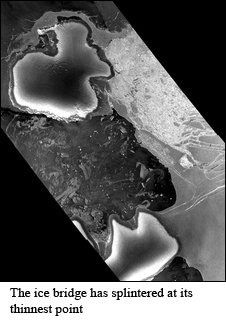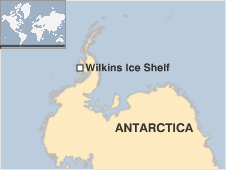Ice bridge ruptures in Antarctic
 An ice bridge linking a shelf of ice the size of Jamaica to two islands in Antarctica has snapped. Life as we know its about to change faster than ever before as we beome ice free by 2020.
An ice bridge linking a shelf of ice the size of Jamaica to two islands in Antarctica has snapped. Life as we know its about to change faster than ever before as we beome ice free by 2020.Scientists say the collapse could mean the Wilkins Ice Shelf is on the brink of breaking away, and provides further evidence of rapid change in the region.
Sited on the western side of the Antarctic Peninsula, the Wilkins shelf has been retreating since the 1990s.
Researchers regarded the ice bridge as an important barrier, holding the remnant shelf structure in place.
Its removal will allow ice to move more freely between Charcot and Latady islands, into the open ocean.
European Space Agency satellite pictures had indicated last week that cracks were starting to appear in the bridge. Newly created icebergs were seen to be floating in the sea on the western side of the peninsula, which juts up from the continent towards South America’s southern tip.
Professor David Vaughan is a glaciologist with the British Antarctic Survey who planted a GPS tracker on the ice bridge in January to monitor its movement.
He said the breaking of the bridge had been expected for some weeks and much of the ice shelf behind was likely to follow.
“We know that [the Wilkins Ice Shelf] has been completely or very stable since the 1930s and then it started to retreat in the late 1990s. But we suspect that it’s been stable for a very much longer period than that,” he told BBC News.
“The fact that it’s retreating and now has lost connection with one of its islands is really a strong indication that the warming on the Antarctic is having an effect on yet another ice shelf.”

While the break-up will have no direct impact on sea level because the ice is floating, it heightens concerns over the impact of climate change on this part of Antarctica.
Over the past 50 years, the peninsula has been one of the fastest warming places on the planet.
Many of its ice shelves have retreated in that time and six of them have collapsed completely (Prince Gustav Channel, Larsen Inlet, Larsen A, Larsen B, Wordie, Muller and the Jones Ice Shelf).
Separate research shows that when ice shelves are removed, the glaciers and landed ice behind them start to move towards the ocean more rapidly. It is this ice which can raise sea levels, but by how much is a matter of ongoing scientific debate.
Such acceleration effects were not included by the UN’s Intergovernmental Panel on Climate Change (IPCC) when it made its latest projections on likely future sea level rise. Its 2007 assessment said ice dynamics were poorly understood.
BBC News website
You can return to the main Market News page, or press the Back button on your browser.

